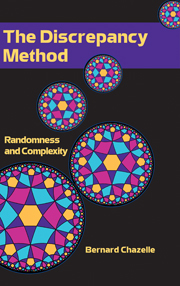Refine search
Actions for selected content:
48167 results in Computer Science

The Discrepancy Method
- Randomness and Complexity
-
- Published online:
- 05 October 2013
- Print publication:
- 24 July 2000
ROB volume 31 issue 7 Cover and Front matter
-
- Article
-
- You have access
- Export citation
ROB volume 31 issue 7 Cover and Back matter
-
- Article
-
- You have access
- Export citation
Editorial
-
- Article
-
- You have access
- Export citation
CPC volume 22 issue 6 Cover and Back matter
-
- Journal:
- Combinatorics, Probability and Computing / Volume 22 / Issue 6 / November 2013
- Published online by Cambridge University Press:
- 01 October 2013, pp. b1-b8
-
- Article
-
- You have access
- Export citation
Minimum Number of k-Cliques in Graphs with Bounded Independence Number
-
- Journal:
- Combinatorics, Probability and Computing / Volume 22 / Issue 6 / November 2013
- Published online by Cambridge University Press:
- 01 October 2013, pp. 910-934
-
- Article
- Export citation
A vanishing theorem and symbolic powers of planar point ideals
- Part of
-
- Journal:
- LMS Journal of Computation and Mathematics / Volume 16 / October 2013
- Published online by Cambridge University Press:
- 01 October 2013, pp. 373-387
-
- Article
-
- You have access
- Export citation
CPC volume 22 issue 6 Cover and Front matter
-
- Journal:
- Combinatorics, Probability and Computing / Volume 22 / Issue 6 / November 2013
- Published online by Cambridge University Press:
- 01 October 2013, pp. f1-f2
-
- Article
-
- You have access
- Export citation
Approximation by a composition of Chlodowsky operators and Százs–Durrmeyer operators on weighted spaces
- Part of
-
- Journal:
- LMS Journal of Computation and Mathematics / Volume 16 / October 2013
- Published online by Cambridge University Press:
- 01 October 2013, pp. 388-397
-
- Article
-
- You have access
- Export citation
12 - Applications of BCIs
- from Part IV - Applications and Ethics
-
- Book:
- Brain-Computer Interfacing
- Published online:
- 05 October 2013
- Print publication:
- 30 September 2013, pp 239-271
-
- Chapter
- Export citation
4 - Signal Processing
- from Part I - Background
-
- Book:
- Brain-Computer Interfacing
- Published online:
- 05 October 2013
- Print publication:
- 30 September 2013, pp 39-70
-
- Chapter
- Export citation
1 - Introduction
-
- Book:
- Brain-Computer Interfacing
- Published online:
- 05 October 2013
- Print publication:
- 30 September 2013, pp 1-4
-
- Chapter
- Export citation
10 - BCIs that Stimulate
- from Part III - Major Types of BCIs
-
- Book:
- Brain-Computer Interfacing
- Published online:
- 05 October 2013
- Print publication:
- 30 September 2013, pp 210-220
-
- Chapter
- Export citation
9 - Noninvasive BCIs
- from Part III - Major Types of BCIs
-
- Book:
- Brain-Computer Interfacing
- Published online:
- 05 October 2013
- Print publication:
- 30 September 2013, pp 177-209
-
- Chapter
- Export citation
Preface
-
- Book:
- Brain-Computer Interfacing
- Published online:
- 05 October 2013
- Print publication:
- 30 September 2013, pp xiii-xvi
-
- Chapter
- Export citation
Appendix - Mathematical Background
-
- Book:
- Brain-Computer Interfacing
- Published online:
- 05 October 2013
- Print publication:
- 30 September 2013, pp 281-294
-
- Chapter
- Export citation
13 - Ethics of Brain-Computer Interfacing
- from Part IV - Applications and Ethics
-
- Book:
- Brain-Computer Interfacing
- Published online:
- 05 October 2013
- Print publication:
- 30 September 2013, pp 272-278
-
- Chapter
- Export citation
Part IV - Applications and Ethics
-
- Book:
- Brain-Computer Interfacing
- Published online:
- 05 October 2013
- Print publication:
- 30 September 2013, pp 237-238
-
- Chapter
- Export citation
Index
-
- Book:
- Brain-Computer Interfacing
- Published online:
- 05 October 2013
- Print publication:
- 30 September 2013, pp 307-319
-
- Chapter
- Export citation
Dedication
-
- Book:
- Brain-Computer Interfacing
- Published online:
- 05 October 2013
- Print publication:
- 30 September 2013, pp v-vi
-
- Chapter
- Export citation



